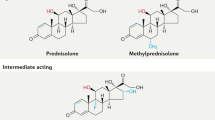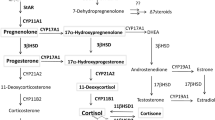Abstract
The strong anti-inflammatory and immunosuppressive effects of glucocorticoids are mediated primarily by the cytosolic glucocorticoid receptors. These receptors are members of the steroid hormone receptor family, a superfamily of ligand-inducible transcription factors, and exert genomic effects that can result in increased expression of regulatory—including anti-inflammatory—proteins (transactivation), or decreased production of proinflammatory proteins (transrepression). Transactivation is thought to be responsible for numerous adverse effects of glucocorticoids; transrepression is thought to be responsible for many of the clinically desirable anti-inflammatory and immunosuppressive effects of glucocorticoids. Optimized glucocorticoids, such as selective glucocorticoid receptor agonists, are being developed to try to minimize the adverse effects many patients experience. Glucocorticoids also exert their effects via rapid, nongenomic mechanisms that can be classified as involving nonspecific interactions of glucocorticoids with cellular membranes, nongenomic effects that are mediated by cytosolic glucocorticoid receptors, or specific interactions with membrane-bound glucocorticoid receptors. Increased understanding of these mechanisms of glucocorticoid action could enable the development of novel drugs with which to treat patients with inflammatory and autoimmune disease.
Key Points
-
Glucocorticoids are powerful and cost-effective drugs for the treatment of various rheumatic diseases
-
Several adverse effects limit the successful therapeutic use of glucocorticoids, especially if used at high doses for long periods of time
-
The strong anti-inflammatory and immunosuppressive effects are mediated by genomic and nongenomic mechanisms of action
-
A greater understanding of the detailed mechanisms of glucocorticoid action is required to improve the benefit:risk ratio of glucocorticoid therapy
-
Current intensive research focuses on the optimization of conventional glucocorticoid use (for drugs that are already available) and on the development of novel glucocorticoid receptor ligands
This is a preview of subscription content, access via your institution
Access options
Subscribe to this journal
Receive 12 print issues and online access
$209.00 per year
only $17.42 per issue
Buy this article
- Purchase on Springer Link
- Instant access to full article PDF
Prices may be subject to local taxes which are calculated during checkout


Similar content being viewed by others
References
Buttgereit F et al. (2005) Optimised glucocorticoid therapy: the sharpening of an old spear. Lancet 365: 801–803
Thiele K et al. (2005) Current use of glucocorticoids in patients with rheumatoid arthritis in Germany. Arthritis Rheum 53: 740–747
Buttgereit F et al. (2004) Glucocorticoids in the treatment of rheumatic diseases: an update on the mechanisms of action. Arthritis Rheum 50: 3408–3417
Bijlsma JW et al. (2006) Are glucocorticoids DMARDs? Ann NY Acad Sci 1069: 268–274
Stahn C et al. (2007) Molecular mechanisms of glucocorticoid action and selective glucocorticoid receptor agonists. Mol Cell Endocrinol 275: 71–78
Buttgereit F et al. (2005) The molecular basis for the effectiveness, toxicity, and resistance to glucocorticoids: focus on the treatment of rheumatoid arthritis. Scand J Rheumatol 34: 14–21
Buttgereit F et al. (2008) Chapter 87: Glucocorticoids. In Clinical Immunology: principles and practice, edn 3 (Eds Rich R. et al.) Philadelphia: Mosby Elsevier
Schacke H et al. (2004) Dissociation of transactivation from transrepression by a selective glucocorticoid receptor agonist leads to separation of therapeutic effects from side effects. Proc Natl Acad Sci USA 101: 227–232
Da Silva JA et al. (2006) Safety of low dose glucocorticoid treatment in rheumatoid arthritis: published evidence and prospective trial data. Ann Rheum Dis 65: 285–293
van Staa TP et al. (2000) Oral corticosteroids and fracture risk: relationship to daily and cumulative doses. Rheumatology (Oxford) 39: 1383–1389
Da Silva JA et al. (2006) Revisiting the toxicity of low-dose glucocorticoids: risks and fears. Ann NY Acad Sci 1069: 275–288
Buttgereit F et al. (2002) Standardised nomenclature for glucocorticoid dosages and glucocorticoid treatment regimens: current questions and tentative answers in rheumatology. Ann Rheum Dis 61: 718–722
Hoes JN et al. (2007) EULAR evidence-based recommendations on the management of systemic glucocorticoid therapy in rheumatic diseases. Ann Rheum Dis 66: 1560–1567
Buttgereit F and Burmester GR (2008) Glucocorticoids. In Primer on Rheumatic Diseases, edn 13, 644–650 (Eds Klippel JH. et al.) Berlin, Germany: Springer
Bijlsma JW et al. (2007) Systemic and intra-articular glucocorticoids in rheumatoid arthritis. In Rheumatoid arthritis, edn 2, 337–353 (Eds Firestein G. et al.) New York: Oxford University Press
Schacke H et al. (2002) Mechanisms involved in the side effects of glucocorticoids. Pharmacol Ther 96: 23–43
Adcock IM and Lane SJ (2003) Corticosteroid-insensitive asthma: molecular mechanisms. J Endocrinol 178: 347–355
Wikstrom AC (2003) Glucocorticoid action and novel mechanisms of steroid resistance: role of glucocorticoid receptor-interacting proteins for glucocorticoid responsiveness. J Endocrinol 178: 331–337
Almawi WY and Melemedjian OK (2002) Molecular mechanisms of glucocorticoid antiproliferative effects: antagonism of transcription factor activity by glucocorticoid receptor. J Leukoc Biol 71: 9–15
Buttgereit F and Scheffold A (2002) Rapid glucocorticoid effects on immune cells. Steroids 67: 529–534
Pratt WB (1998) The hsp90-based chaperone system: involvement in signal transduction from a variety of hormone and growth factor receptors. Proc Soc Exp Biol Med 217: 420–434
Lowenberg M et al. (2008) Novel insights into mechanisms of glucocorticoid action and the development of new glucocorticoid receptor ligands. Steroids 73: 1025–1029
Hollenberg SM et al. (1985) Primary structure and expression of a functional human glucocorticoid receptor cDNA. Nature 318: 635–641
Lu NZ and Cidlowski JA (2004) The origin and functions of multiple human glucocorticoid receptor isoforms. Ann NY Acad Sci 1024: 102–123
Chikanza IC (2002) Mechanisms of corticosteroid resistance in rheumatoid arthritis: a putative role for the corticosteroid receptor beta isoform. Ann NY Acad Sci 966: 39–48
Oakley RH et al. (1999) The dominant negative activity of the human glucocorticoid receptor beta isoform. Specificity and mechanisms of action. J Biol Chem 274: 27857–27866
Bodwell JE et al. (1991) Identification of phosphorylated sites in the mouse glucocorticoid receptor. J Biol Chem 266: 7549–7555
Webster JC et al. (1997) Mouse glucocorticoid receptor phosphorylation status influences multiple functions of the receptor protein. J Biol Chem 272: 9287–9293
McEwan IJ et al. (1993) Direct interaction of the tau 1 transactivation domain of the human glucocorticoid receptor with the basal transcriptional machinery. Mol Cell Biol 13: 399–407
Dahlman-Wright K et al. (1995) Structural characterization of a minimal functional transactivation domain from the human glucocorticoid receptor. Proc Natl Acad Sci USA 92: 1699–1703
MacGregor JI and Jordan VC (1998) Basic guide to the mechanisms of antiestrogen action. Pharmacol Rev 50: 151–196
Beato M and Klug J (2000) Steroid hormone receptors: an update. Hum Reprod Update 6: 225–236
Pratt WB et al. (2006) Chaperoning of glucocorticoid receptors. Handb Exp Pharmacol 172: 111–138
Robertson NM et al. (1993) Demonstration of nuclear translocation of the mineralocorticoid receptor (MR) using an anti-MR antibody and confocal laser scanning microscopy. Mol Endocrinol 7: 1226–1239
Ishaq M et al. (2007) Zap70 signaling pathway mediates glucocorticoid receptor-dependent transcriptional activation: role in the regulation of annexin 1 expression in T cells. J Immunol 179: 3851–3858
Sakai DD et al. (1988) Hormone-mediated repression: a negative glucocorticoid response element from the bovine prolactin gene. Genes Dev 2: 1144–1154
Song IH et al. (2005) New glucocorticoids on the horizon: repress, don't activate! J Rheumatol 32: 1199–1207
De Bosscher K et al. (2000) Glucocorticoids repress NF-κB-driven genes by disturbing the interaction of p65 with the basal transcription machinery, irrespective of coactivator levels in the cell. Proc Natl Acad Sci USA 97: 3919–3924
Nissen RM and Yamamoto KR (2000) The glucocorticoid receptor inhibits NFκB by interfering with serine-2 phosphorylation of the RNA polymerase II carboxy-terminal domain. Genes Dev 14: 2314–2329
Falkenstein E et al. (2000) Mannheim classification of nongenomically initiated (rapid) steroid action(s). J Clin Endocrinol Metab 85: 2072–2075
Schacke H et al. (2006) Insight into the molecular mechanisms of glucocorticoid receptor action promotes identification of novel ligands with an improved therapeutic index. Exp Dermatol 15: 565–573
Haller J et al. (2008) The effects of non-genomic glucocorticoid mechanisms on bodily functions and the central neural system. A critical evaluation of findings. Front Neuroendocrinol 29: 273–291
Croxtall JD et al. (2000) Glucocorticoids act within minutes to inhibit recruitment of signalling factors to activated EGF receptors through a receptor-dependent, transcription-independent mechanism. Br J Pharmacol 130: 289–298
Cato AC et al. (2002) Rapid actions of steroid receptors in cellular signaling pathways. Sci STKE 2002: RE9
Hafezi-Moghadam A et al. (2002) Acute cardiovascular protective effects of corticosteroids are mediated by non-transcriptional activation of endothelial nitric oxide synthase. Nat Med 8: 473–479
Buttgereit F et al. (2000) Bioenergetics of immune functions: fundamental and therapeutic aspects. Immunol Today 21: 192–199
Nadal A et al. (2001) The plasma membrane estrogen receptor: nuclear or unclear? Trends Pharmacol Sci 22: 597–599
Gametchu B et al. (1999) Plasma membrane-resident glucocorticoid receptors in rodent lymphoma and human leukemia models. Steroids 64: 107–119
Orchinik M et al. (1991) A corticosteroid receptor in neuronal membranes. Science 252: 1848–1851
Bartholome B et al. (2004) Membrane glucocorticoid receptors (mGCR) are expressed in normal human peripheral blood mononuclear cells and up-regulated after in vitro stimulation and in patients with rheumatoid arthritis. FASEB J 18: 70–80
Song IH and Buttgereit F (2006) Non-genomic glucocorticoid effects to provide the basis for new drug developments. Mol Cell Endocrinol 246: 142–146
Tryc AB et al. (2006) Membrane glucocorticoid receptor expression on peripheral blood mononuclear cells in patients with ankylosing spondylitis. J Rheumatol 33: 2249–2253
Spies CM et al. (2006) Membrane glucocorticoid receptors are down regulated by glucocorticoids in patients with systemic lupus erythematosus and use a caveolin-1-independent expression pathway. Ann Rheum Dis 65: 1139–1146
Löwenberg M et al. (2005) Rapid immunosuppressive effects of glucocorticoids mediated through Lck and Fyn. Blood 106: 1703–1710
Löwenberg M et al. (2006) Glucocorticoids cause rapid dissociation of a T-cell-receptor-associated protein complex containing LCK and FYN. EMBO Rep 7: 1023–1029
Schmidt J et al. (2003) Drug targeting by long-circulating liposomal glucocorticosteroids increases therapeutic efficacy in a model of multiple sclerosis. Brain 126: 1895–1904
Metselaar JM et al. (2003) Complete remission of experimental arthritis by joint targeting of glucocorticoids with long-circulating liposomes. Arthritis Rheum 48: 2059–2066
Perretti M et al. (2003) Generation of innovative anti-inflammatory and anti-arthritic glucocorticoid derivatives that release NO: the nitro-steroids. Dig Liver Dis 35 (Suppl 2): S41–S48
Paul-Clark MJ et al. (2002) Potent antiarthritic properties of a glucocorticoid derivative, NCX-1015, in an experimental model of arthritis. Proc Natl Acad Sci USA 99: 1677–1682
Paul-Clark MJ et al. (2003) Glucocorticoid receptor nitration leads to enhanced anti-inflammatory effects of novel steroid ligands. J Immunol 171: 3245–3252
Buttgereit F et al. (2008) Efficacy of modified-release versus standard prednisone to reduce duration of morning stiffness of the joints in rheumatoid arthritis (CAPRA-1): a double-blind, randomised controlled trial. Lancet 371: 205–214
Schacke H et al. (2007) Selective glucocorticoid receptor agonists (SEGRAs): novel ligands with an improved therapeutic index. Mol Cell Endocrinol 275: 109–117
Lin CW et al. (2002) Trans-activation and repression properties of the novel nonsteroid glucocorticoid receptor ligand 2,5-dihydro-9-hydroxy-10-methoxy-2,2,4-trimethyl-5-(1-methylcyclohexen-3-y1) -1H-[1]benzopyrano[3,4-f]quinoline (A276575) and its four stereoisomers. Mol Pharmacol 62: 297–303
Miner JN et al. (2007) Anti-inflammatory glucocorticoid receptor ligand with reduced side effects exhibits an altered protein-protein interaction profile. Proc Natl Acad Sci USA 104: 19244–19249
Lopez FJ et al. (2008) LGD5552, an anti-inflammatory glucocorticoid receptor ligand with reduced side effects, in vivo. Endocrinology 149: 2080–2089
Author information
Authors and Affiliations
Corresponding author
Ethics declarations
Competing interests
F Buttgereit has declared that he has been a consultant for, and received speakers bureau and grant/research support from, Merck Pharma GmbH and NiTech Pharma GmbH. F Buttgereit has also been a consultant for Organon. C Stahn declared no competing interests.
Rights and permissions
About this article
Cite this article
Stahn, C., Buttgereit, F. Genomic and nongenomic effects of glucocorticoids. Nat Rev Rheumatol 4, 525–533 (2008). https://doi.org/10.1038/ncprheum0898
Received:
Accepted:
Published:
Issue Date:
DOI: https://doi.org/10.1038/ncprheum0898
This article is cited by
-
Treatment of multisystem inflammatory syndrome in children
World Journal of Pediatrics (2024)
-
Molecular Cardiotoxic Effects of Proteasome Inhibitors Carfilzomib and Ixazomib and Their Combination with Dexamethasone Involve Mitochondrial Dysregulation
Cardiovascular Toxicology (2023)
-
Glucocorticoid-Induced Osteoporosis (GIOP)
Indian Journal of Orthopaedics (2023)
-
Current treatment of systemic lupus erythematosus: a clinician's perspective
Rheumatology International (2023)
-
Differential distribution of steroid hormone signaling networks in the human choroid-retinal pigment epithelial complex
BMC Ophthalmology (2022)



